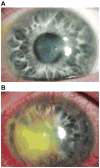Herpes keratitis
- PMID: 22944008
- PMCID: PMC3529813
- DOI: 10.1016/j.preteyeres.2012.08.002
Herpes keratitis
Abstract
Herpes simplex virus-1 (HSV-1) infects the majority of the world's population. These infections are often asymptomatic, but ocular HSV-1 infections cause multiple pathologies with perhaps the most destructive being herpes stromal keratitis (HSK). HSK lesions, which are immunoinflammatory in nature, can recur throughout life and often cause progressive corneal scaring resulting in visual impairment. Current treatment involves broad local immunosuppression with topical steroids along with antiviral coverage. Unfortunately, the immunopathologic mechanisms defined in animal models of HSK have not yet translated into improved therapy. Herein, we review the clinical epidemiology and pathology of the disease and summarize the large amount of basic research regarding the immunopathology of HSK. We examine the role of the innate and adaptive immune system in the clearance of virus and the destruction of the normal corneal architecture that is typical of HSK. Our goal is to define current knowledge of the pathogenic mechanisms and recurrent nature of HSK and identify areas that require further study.
Copyright © 2012 Elsevier Ltd. All rights reserved.
Figures


References
-
- The collaborative corneal transplantation studies (CCTS). Effectiveness of histocompatibility matching in high-risk corneal transplantation. The Collaborative Corneal Transplantation Studies Research Group. Arch Ophthalmol. 1992;110:1392–1403. - PubMed
-
- Acyclovir for the prevention of recurrent herpes simplex virus eye disease. Herpetic Eye Disease Study Group. N Engl J Med. 1998;339:300–306. - PubMed
-
- Allan RS, Smith CM, Belz GT, van Lint AL, Wakim LM, Heath WR, Carbone FR. Epidermal viral immunity induced by CD8alpha+ dendritic cells but not by Langerhans cells. Science. 2003;301:1925–1928. - PubMed
-
- Allan RS, Waithman J, Bedoui S, Jones CM, Villadangos JA, Zhan Y, Lew AM, Shortman K, Heath WR, Carbone FR. Migratory dendritic cells transfer antigen to a lymph node-resident dendritic cell population for efficient CTL priming. Immunity. 2006;25:153–162. - PubMed
-
- Ambati BK, Anand A, Joussen AM, Kuziel WA, Adamis AP, Ambati J. Sustained inhibition of corneal neovascularization by genetic ablation of CCR5. Invest Ophthalmol Vis Sci. 2003;44:590–593. - PubMed
Publication types
MeSH terms
Substances
Grants and funding
LinkOut - more resources
Full Text Sources
Other Literature Sources

